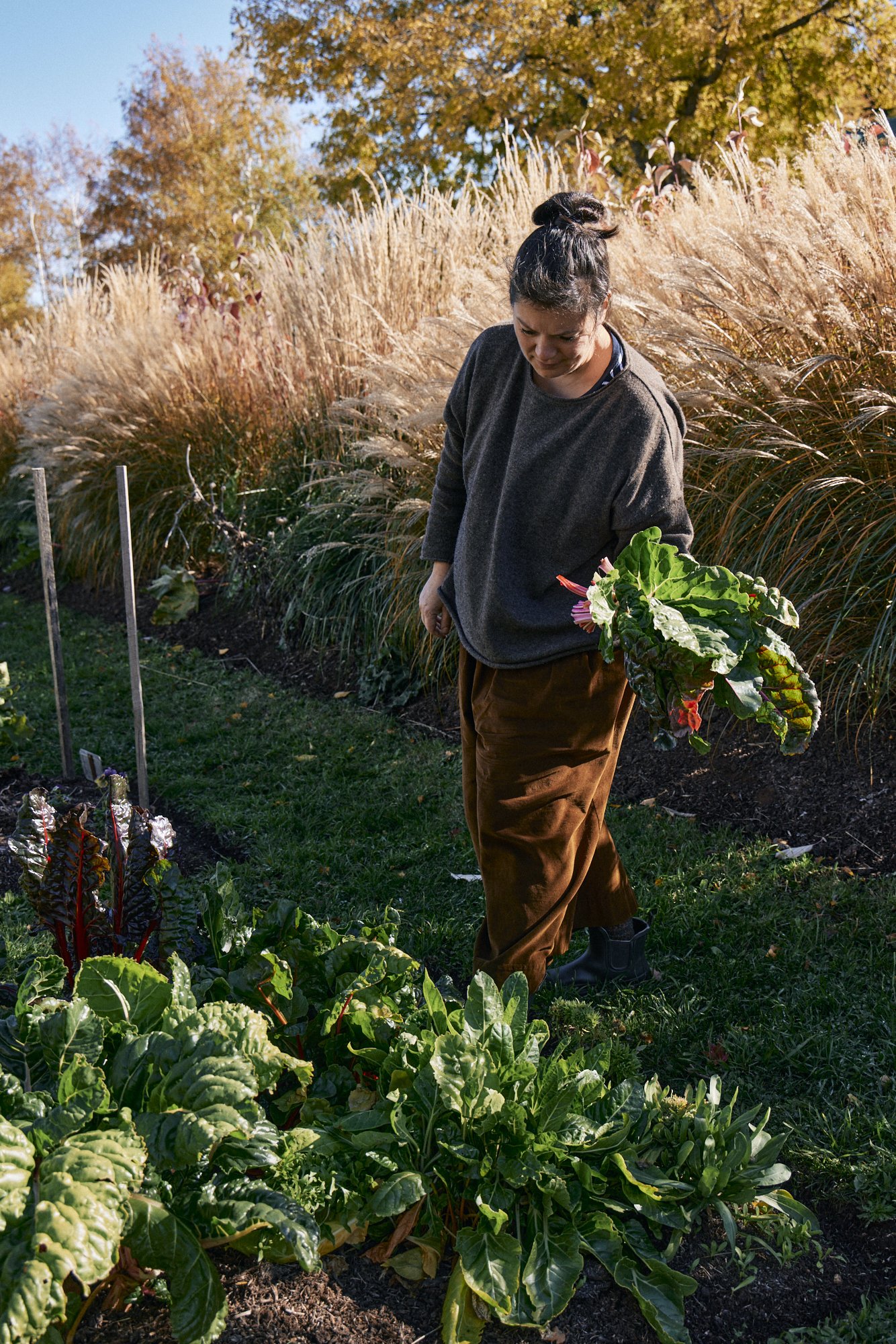As we head toward winter here in the southern hemisphere, it’s the time of year when I’m often asked: Should I be cutting back my grasses now?
My answer, more often than not, is not yet.
For many of us, ornamental grasses are still holding strong—bleached, upright, architectural. They continue to offer form, movement, and quiet seasonal interest right through the cooler months. Cutting them back too early removes not just their visual contribution, but also the habitats they offer to insects and birds.
So if you’re unsure what to do right now in late May, my suggestion is this: observe closely, and wait if you can. Let the garden keep offering what it still has to give.
Below, I’ve shared what I do in my own garden at this time of year—including when (and whether) to cut back each type of grass, how to divide them, and how to support them through the seasons.
Why I return to grasses, again and again
I return to grasses time and time again. They’re a favourite go-to in my garden design toolkit—they offer structure and softness, but also bring a kind of seasonal rhythm that anchors the garden and that just keeps on giving.
They catch the light, respond to the breeze, and shift with the seasons—moving from verdant to architectural, continuing to anchor the space even through winter.
That’s why I leave mine standing for as long as I can.
Here at Little Cottage on a Hill, the 27-metre long northern planting—filled with Miscanthus, Calamagrostis, Panicum, Molinia and others—does so much of the heavy lifting during the cooler months. It softens the boundary, offers a sense of enclosure, and holds a rhythm at the garden’s edge.
But eventually, they do need cutting back. And each one has its own rhythm.
When to cut back – species by species
Miscanthus (e.g. ‘Eileen Quinn’, ‘Kleine Fontaine’, ‘Yakushima Dwarf’)
Leave standing through winter. Cut back in late winter to early spring, just before new shoots emerge. Trim to around 10–20cm (4–8").
Calamagrostis ‘Karl Foerster’
Often pushes fresh growth early. Cut back in late winter, just before the green blades return. Trim to around 10–15cm (4–6").
Panicum (e.g. ‘Blue Steel’, ‘Iron Maiden’)
Hold their form well into winter. Cut back in late winter or early spring, down to 10–15cm (4–6").
Andropogon scoparius ‘Blaze’
Cut back just before new growth appears in late winter.
Molinia arundinacea
Cut back in late winter. These often flatten with heavy rain or frost, but their form is still beautiful when caught in low light or mist.
And once they’re cut? Don’t be too quick to compost what’s left behind.
Spent grasses make beautiful materials for vases, loose seasonal arrangements, or even twisted into wreaths. Their fine structure, bleached tones, and natural curves bring a quiet, sculptural quality indoors. I often gather armfuls of Miscanthus or Calamagrostis to use around the house—nothing too styled, just simply arranged in a jug or laid across a shelf.
Why not cut grasses back in autumn?
It’s a question I’m asked often—and I understand why. For years, autumn clean-up was the default. But I’ve found that grasses give so much more when left in place:
They provide visual structure and softness when everything else is pared back
They shelter overwintering insects and offer food for birds
They create contrast against bare branches, frosts, and low winter light
They add sound to the garden—seedheads rattling softly in the breeze
Unless the plant has collapsed or rotted at the base, I always choose to leave it be.
Can they be divided? What about in winter?
If a grass is thinning in the centre or starting to dominate a space, division is a simple way to rejuvenate it or create new plantings.
But winter isn’t the ideal time to divide. Most ornamental grasses are dormant through the colder months, and disturbing them too early can lead to stress, rot, or poor re-establishment.
Instead, wait until early spring—just as new growth begins to show. That’s when the crown is active, and divisions settle in more easily. I usually look for the first signs of green shoots before lifting and splitting a clump.
Use a sharp spade to divide the clump cleanly, replant or pot up the divisions, and water them in well. With the full growing season ahead, they’ll re-establish quickly.
Do they need feeding or mulching?
Most ornamental grasses are fairly low maintenance. I do mulch lightly with compost or aged mulch in early spring after cutting back—not to push excessive growth, but to support soil health and give the plants a good start for the season.
Are all grasses safe to leave through winter?
In wetter climates or heavy soils, some grasses can be prone to rotting at the crown if left standing too long. If a grass has flopped or shows signs of decay, it’s perfectly fine to cut it back a little earlier. As always: observe the plant, and respond accordingly.
Can I grow ornamental grasses in pots or small spaces?
Absolutely. Grasses can thrive in containers and smaller gardens—especially those with upright, clump-forming habits. Some of my favourites include:
Calamagrostis ‘Karl Foerster’ – strong vertical structure that holds its shape beautifully
Panicum ‘Blue Steel’ – upright with soft, airy flowering plumes through late summer
Miscanthus ‘Eileen Quinn’ – compact and elegant, ideal for pots or tight borders
The key is choosing varieties that are more restrained in size, and matching their mature height to the scale and depth of the container. A tall grass in a shallow pot will never thrive—so I always make sure the root zone has room to stretch, and the proportions are balanced.
A favourite pairing: grasses, Echinops and Echinacea pallida
One of the things I’ve observed this past year is how well Echinops works structurally in combination with grasses—particularly Calamagrostis. Where I’d planted Echinops ritro just in front of a drift of Calamagrostis ‘Karl Foerster’, the tall, rigid stems of the Echinops acted almost like a scaffold—quietly holding the grasses upright and preventing them from flopping in the wind.
It’s a small detail, but it’s shifted how I think about layering structure in the 27-metre north-facing verge bed. This winter, I’m propagating more Echinops from saved seed so I can carry that rhythm further through the planting. Grasses and Echinops have become one of my favourite combinations—offering contrast, resilience, and structure that carries through the seasons.
I love the way Echinops brings both edge and softness: thistle-like, globe-shaped flowers in mid-summer, followed by intricate seedheads that hold their form through winter. Their upright stems catch the light and hold their line long after flowering is finished—adding texture and subtle architecture to the garden in its quieter months.
Similarly, I’ve long admired the way Echinacea pallida moves with some of the finer, shorter grasses. There’s something so quietly graceful in the pairing—the fine, reflexed petals of the pallida drooping elegantly around a cone of dusky seed, mirrored by the movement of surrounding grasses. Miscanthus ‘Eileen Quinn’ works especially well here—tightly clumped, upright, and modest in scale without losing presence.
Other compact grasses I return to for these kinds of pairings include:
Panicum ‘Blue Steel’ – fine-textured with gentle autumn tones
Miscanthus ‘Kleine Fontaine’ – with a lovely upright form
I like to plant in drifts of four or five—a rhythm that brings coherence without feeling too uniform. It’s a tip shared with me by my dear friend Lily Langham, and it’s one I return to often. Whether it’s grasses, Echinacea, or Echinops, that repetition adds a softness and strength to the planting—giving enough body to hold space while still allowing for movement and light.
These combinations bring layered interest, seasonal movement, and a gentle wildness to planting—anchoring the space, yet always shifting with light and breeze.
Where I source my grasses
If you’re looking to introduce more ornamental grasses into your own garden, I’m often asked where I source mine from. These are nurseries I’ve personally used and return to again and again—for their quality, range, and thoughtful curation of plants suited to Australian conditions:
Antique Perennials – in King Lake, with a beautiful range of grasses and perennials that work beautifully in seasonal planting
Lambley Nursery and Gardens – in Ascot, known for their dry-climate plant palette and strong garden performance
The Diggers Club – online and their wonderful three Victoria locations, especially good for accessible, well-labelled plants and beginner-friendly information
If you know of any other specialist nursery you trust, I’d love to hear.
Wherever you source your plants, make sure to check the mature size, form, and growth habit—it makes all the difference when selecting grasses for the right rhythm, scale, and movement in your space. I’ve made mistakes in the past, assuming that Miscanthus ‘Yukashima Dwarf’ was in fact a dwarf, and I can guarantee you it certainly is not! (I’ll be shifting a clump of it this winter away from the front of a bed!!)
Some things I’ve learnt over time
Leave grasses standing through winter if they’re still holding well
Cut back in late winter to early spring, just before new growth appears
Divide in early spring—not winter—when growth begins
Mulch lightly after cutting back
Observe your climate and plant condition before acting
Use spent grass stems for sculptural arrangements or natural wreaths
You may want to check out my related content below:
My Top 3 Grasses For All Seasons Gardens – Discover the best ornamental grasses that bring year-round beauty and structure to your garden.
Curious about ornamental grasses?
If you’re exploring how to bring beauty, softness, and structure into your garden—whether through boundary planting, small courtyard moments, or grasses that catch the light just so—I share more in my e-books. They offer guidance on planting design, seasonal care, and combinations that bring function and beauty together.
→ Browse the e-books for more insight into thoughtful planting and garden layering.
→ Share this post with friends who love grasses as much as you do.
→ Sign up for the newsletter to receive seasonal tips, workshop updates, and more from Little Cottage on a Hill.
Thanks so much for following along.
Natasha xx
For glimpses into workshops, daily life, and my thoughts from Little Cottage on a Hill, you can find me on Instagram, Facebook, LinkedIn, and YouTube. And if you’d like a more personal update, subscribe to my Newsletter for a monthly note on what’s growing, what’s inspiring me, and what’s next.
Click the links below to stay connected—I’d love to have you along for the journey.



















